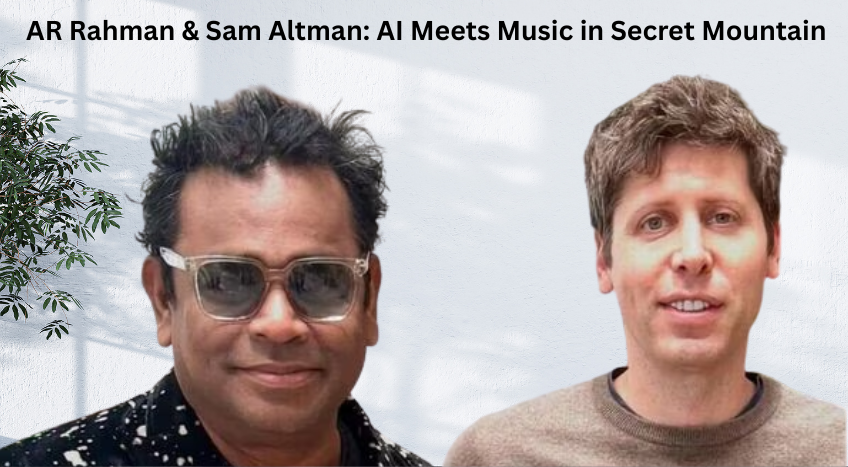The Moment That Changes the Score
What happens when A.R. Rahman, the Oscar-winning sonic alchemist who made entire cities hum in D-minor, meets Sam Altman, the entrepreneur steering the most influential AI meets music. You don’t just get a headline—you get a hypothesis for the future of music.
Call it Secret Mountain: a creative playground where AI doesn’t replace composers—it becomes their most expressive instrument. Imagine Rahman’s instincts and cultural intuition fused with a model stack that can hear, feel, and respond to human emotion at scale.
Why This Collaboration Matters (Beyond the Hype
The usual narrative around AI meets music swings between utopia (infinite creativity!) and apocalypse (RIP, artists!). But the Rahman–Altman axis reframes the conversation:
Cultural Intelligence > Generic Generativity: Indian classical music—its raagas, talas, microtonal subtleties, and improvisational grammar—is vastly underrepresented in mainstream generative datasets. Building culturally aligned music models demands artists like A.R Rahman to teach AI what taste means.
Co-Creation, not Automation: Replace the idea of “AI writes the score” with “AI extends the composer’s reach”. AI becomes a style engine, not a style thief.
Rights, Royalties & Provenance: If AI is trained on your timbre or your raga improvisations, you should get paid—every time. Transparent attribution pipelines and smart contracts can make that real.
Inside Secret Mountain: A Hypothetical Pipeline
Let’s architect how an AI-native album-film-concert could work:
1) The Dataset: Culture-Aware, Legally Clean
Curated Raaga Library: Thousands of hours of properly licensed recordings tagged with raagas, talas, gamakas, emotional tone, lyrical semantics, and performance context.
Lyric Intelligence: Multilingual corpora (Tamil, Hindi, Urdu, English) that embed poetic devices, phonetic rhythm, and regional idioms.
Timbre Maps: Instruments like nadaswaram, veena, mridangam, ghatam, and modern synths profiled for neural timbre transfer.
2) The Model Stack
Foundation Audio Models for texture generation (diffusion or autoregressive), fine-tuned with Indian classical and global pop.
Transformer-Based Composition Models (tokenized symbolic music—like MIDI, Carnatic notation, and bespoke schemas for microtonality).
Conversational LLM Co-Composer: You describe a scene—“monsoon night, 3 AM, raag Bhairavi emotions, tempo 72”—and the model drafts structure, motif families, and possible orchestration layers.
RLHF for Musical Taste: Human feedback (Rahman, his team, and trained listeners) reward what sounds authentic, fresh, and contextually coherent.
3) Human-in-the-Loop Orchestration
Interactive Conducting: Rahman tweaks parameters—ragam purity, improvisation length, microtone bend width, lyrical phoneme density—and the system responds in real time.
Hybrid Workstations: DAWs that aren’t just timelines and waveforms, but latent space navigators—where composers can steer probability clouds instead of raw audio only.
4) Distribution as a Living System
Adaptive Soundtracks: The album adapts to listener context—time of day, mood tagging, hardware EQ profile, even vibe of the surrounding acoustic space.
Own Your Stem: Fans could mint stems or remix rights as NFT-backed micro-licenses with baked-in splits to A.R Rahman, ensemble artists, lyricists, and even the trainers who shaped the models.
Beyond the Studio: Concerts as Intelligent Worlds
Picture this: A Secret Mountain World Tour where the score is semi-generative. Each city gets a culturally tuned improvisational layer, using:
Real-time Latent Improvisation: A model listens to the live audience (cheer intensity, pace, ambient noise) and nudges the arrangement.
XR/AR Immersion: Visuals composed by diffusion video models respond to both raag shifts and percussion dynamics.
Haptic Feedback wearables allow audiences to feel tala cycles—literally making rhythm a tactile experience.
The Ethical & Legal Backbone
If AI is “the new instrument,” we need a new score for rights:
Provenance Graphs: Every bar, phrase, timbre, and lyric transformation must be traceable—not just for accountability, but for revenue attribution.
AI Watermarking: Invisible but detectable marks baked into outputs to prove origin and prevent deepfake misuse of an artist’s voice.
Consent Protocols: Training on a singer’s meend, a guitarist’s pluck style, or a composer’s voicing choices needs explicit, revocable consent.
Dynamic Royalties & DAOs: Imagine a Secret Mountain DAO where contributors (artists, curators, model trainers, data annotators) earn automatically as the music lives, mutates, and grows.
India’s Edge: The World’s Most Under-Modeled Musical Intelligence
India’s unparalleled diversity of musical systems—from Dhrupad to Sufi, Carnatic to Indie Electronica—is a goldmine for AI models that learn nuance over noise. With A.R Rahman as a steward and Altman’s model ecosystem as the scalable substrate, India can define the global benchmark for culturally respectful generative music.
What This Means for Creators
Don’t fear AI—design it. Your taste, cultural literacy, and personal stories are the moat. Teach models what you value.
Own your data. Track your influence. Push for licensing-first datasets, artist collectives, and transparent tooling.
Learn to speak to models: Prompting is the new orchestration. Controllerism for the 2030s will be linguistic, probabilistic, and parametric.
What This Means for the Industry
Label 3.0 = Model Ops + IP Graphs + Fan Economies
Streaming Evolves to “Scening”: Instead of streaming fixed tracks, fans enter scenes—music responds to context, ritual, and identity.
Compliance as a Feature: Platforms that guarantee clean training data, transparent splits, and model governance will win artist trust.
The Research Frontier: Open Problems to Solve
Raga-Constrained Generation: How do models ensure raga fidelity while still enabling novel improvisation?
Emotion-to-Orchestration Mapping: Creating robust affect embeddings that are culturally aware and non-Western biased.
Temporal Coherence in Long Form: Generating 12–20 minute pieces with structural integrity and thematic recurrence.
Voice Preservation without Identity Hijack: Can we clone timbre but disallow identity misuse via cryptographic keys and live consent checks?
The Philosophy: From Score to System
Traditionally, a composer writes a score, musicians play it, and audiences listen. In Secret Mountain, the score is a system, and the system is alive—updated by listener feedback loops, artist-curated fine-tuning, and ethical governance.
The maestro meets the model builder—not to negotiate turf, but to co-create a new instrument. One that remembers, learns, respects, and responds.
The Last Note
If Secret Mountain is more than an idea—if it becomes the first large-scale, ethically trained, culturally grounded, artist-led AI music universe—then Rahman and Altman won’t just have met. They’ll have changed how the world hears itself.
Welcome to the future of listening.


